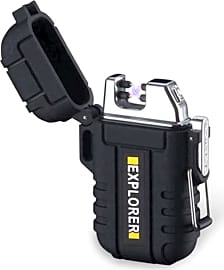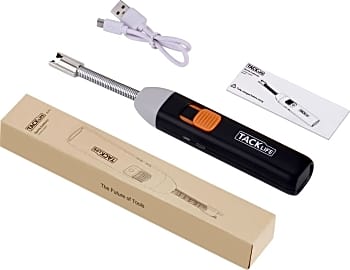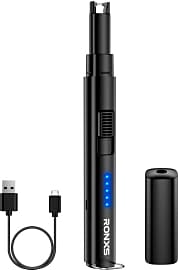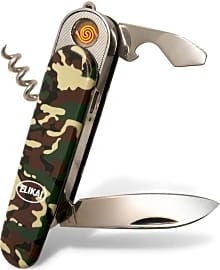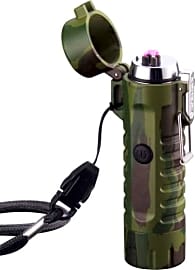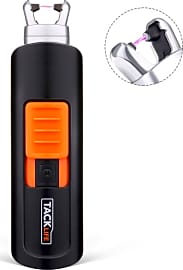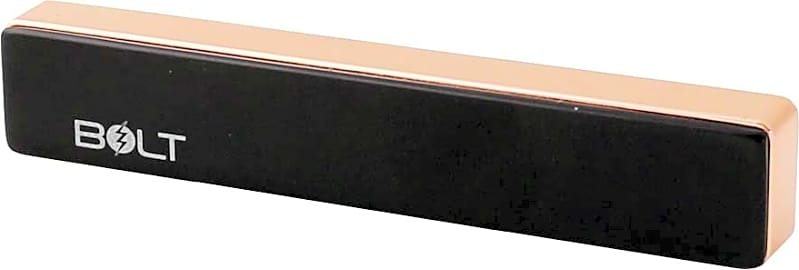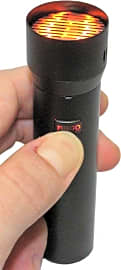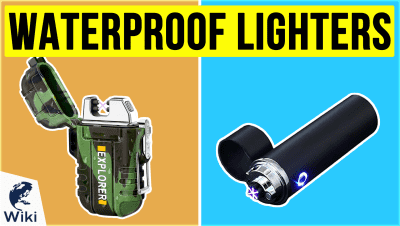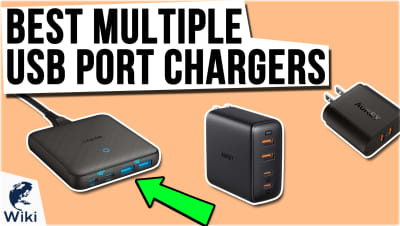The 9 Best USB Lighters

This wiki has been updated 36 times since it was first published in October of 2016. Fire has been around forever, but safe and reliable means of creating it are relatively modern. These high-tech lighters are the latest way to ignite incense, barbecues, smokables, and more, and they're powered by USB-rechargeable batteries. They are available for various applications, so make sure to select the plasma or coil configuration that best fits your intended use. When users buy our independently chosen editorial recommendations, we may earn commissions to help fund the Wiki.
Editor's Notes
January 29, 2021:
We removed a couple lesser-known models that proved to not hold up so well in the long run, and among the remaining recommendations, the Tesla Coil, TackLife Long Neck, and TackLife ELY03 have the best reputations for long-term durability. That's not to say that options like the Jinlun Windproof and LCFun Rechargeable aren't durable, though -- in fact, their reliable caps make them quite reliable indeed. We did add the Elikai Multitool because of its versatility at camp or on the trail, and as long as you use some sort of paper product as your initial fire starter, it can even help you set up a campfire.
January 08, 2020:
There are two common types of USB rechargeable lighters; they're all windproof and some of them are designed to be waterproof, though we wouldn't advise taking them swimming. The Bolt Rechargeable is an incredibly convenient coil-style option because it fits into most cigarette packs once a couple have been removed, and the same can be said for the LCFun Black. Those are both meant almost exclusively for cigarettes, though, while the Fuego Electric can be used for up to 1-inch-thick cigars, but beware that if you're overly aggressive while cleaning it, the coil's connection could be damaged.
Then there are arc lighters that pass a surprisingly powerful electric charge through the air, igniting all manner of flammable materials without any fuel or warm-up time. The TackLife ELY03 and TackLife Long Neck are both pretty similar; their large and easy-to-press button plus their durable construction make them good for utility use around the house. Because the Ronxs Portable is so long, it's perfect for lighting candles without having to tip the candle to the side, and because there's no flame, you don't have to worry about burning your knuckles while doing so.
The LCFun Rechargeable has a built-in flashlight that makes it great for natural disaster kits, and the Jinlun Windproof is especially durable. Both have locking clips that claim to make them completely waterproof; we've even seen reports of them going through the washer and coming out completely unharmed. The AngLink Plasma is an excellent choice for a fun night thanks to a corkscrew and pocket knife than can help to liberate stubborn beverage toppers. And if you want to light cigarettes or campfires and look good doing it, check out the Tesla Coil, which is one of the most popular and reliable.
A Brief History Of The Cigarette Lighter
Döbereiner's lamp, as is was called, uses a chemical reaction between zinc and sulfuric acid to create flammable hydrogen gas.
While they can now be found at the counter of virtually any convenience store, gas station, or newsstand, the portable lighter's history only dates back about 200 years. The first lighter was developed by Johann Wolfgang Döbereiner, a German chemist, in 1823.
Döbereiner's lamp, as is was called, uses a chemical reaction between zinc and sulfuric acid to create flammable hydrogen gas. The gas is then let out of the glass-encased device through a valve, at the mouth of which lies a piece of platinum gauze. The gas meets the platinum, which acts as a catalyst for an exothermic reaction between the hydrogen and the oxygen in the air, causing the platinum to get extremely hot. The heat it generates ignites the hydrogen gas, and the flame can be controlled by opening or closing the valve.
Unfortunately, though it was in production for nearly 80 years, Döbereiner's lamp was too dangerous for widespread adoption. By design, it traps leftover hydrogen gas inside after each use, making it highly explosive. It was also large and delicate, making it difficult to transport.
It wasn't until the patenting of ferrocerium in 1903 that the truly portable lighter became a possibility. Ferrocerium is a type of synthetic flint which produces extremely hot sparks when oxidized, which can be achieved with friction. Unlike flint, which creates sparks from the material used to strike it, when a hard metal like steel strikes a piece of ferrocerium, the sparks are actually flaming hot bits of the latter material itself. It is significantly cheaper than flint, making it ideal for use in disposable lighters.
Though contemporary models have all sorts of features designed to make your life easier, the lighters developed at the beginning of the 20th used the same basic technologies most lighters rely on today. They typically consist of a reservoir filled with a liquid fuel, such as naphtha or butane, with a wick that leads up to a nozzle. Next to the mouth of the nozzle sits a piece of ferrocerium (or, in some cases, actual flint), and a metal wheel which, when spun, generates friction against the stone and produces sparks. The sparks meet the fuel at the nozzle's opening and create a flame, which is often adjustable by opening or closing the nozzle. Various improvements, including wind and water-proof designs, were introduced beginning in the 1930s.
Notable exceptions to the standard include flameless lighters, such as those found built into many automobiles, as well as electric arc lighters, which use a steady spark for ignition. Both of these technologies are common among USB-powered models.
What Makes USB Lighters Different
USB lighters build on the standard portable lighter by replacing liquid fuel with electricity. This means they can never run out of fuel, as all that is required is a quick recharge in any USB port. It also makes them safer, as they contain no combustible elements, sparks, or liquid fuel-filled chambers. They can also usually be used in windy conditions, though, as they are electronic devices, they are mostly not waterproof.
Most USB lighters use one of two technologies. Each has its own benefits and drawbacks, but both are considered highly safe and effective for most uses. The first is the electric arc lighter, which is both a handy companion and a eye-catching gadget, thanks to the visible stream of electricity it generates.
It also makes them safer, as they contain no combustible elements, sparks, or liquid fuel-filled chambers.
Electric arc lighters are powered by built-in rechargeable batteries. Some models plug directly into USB ports, while others require the use of an external charging cable. They work by placing two electrodes close enough to one another that, when a current from the battery is passed through one, it jumps through the air to the other. The current ionizes the air as it passes through, producing plasma, which is why models of this type are often called plasma lighters. Some models use two pairs of electrodes for a visual "x" effect.
The other popular type of USB lighter is similar to those found in most cars. It uses a metal coil that generates heat when an electric current passes through it. This type of lighter is best suited to igniting cigarettes and other things that catch flame easily. It would likely not be effective for starting a campfire on its own, for example, though it could be used to set a match or piece of paper alight, which could then be used for other purposes where a flame is necessary. The technology can be built into very small packages, often with built-in USB connectors that plug directly into a computer or other charging port.
The vast majority of USB lighters have added safety features like slide-out elements and delayed ignition. That way, if their triggers are accidentally pressed, you don't run the risk of lighting your pocket on fire. If you're going camping and are worried that your lighter's battery may not last for its duration, packing an external battery pack can keep the flames alive, so to speak.
A Few Notes On USB Lighter Safety
While there are plenty of safety features built into USB-powered and other flameless lighters, there are still some safety concerns that every user should keep in mind.
A plasma lighter's current is not strong enough to electrocute you, but it is hot enough to burn your skin. In order to effectively ignite paper, the arcs between the electrodes typically reach temperatures of over 2,000 degrees Fahrenheit. That's more than hot enough to do some damage if you come in direct contact with it. It is worth noting, however, that burns from electric arc lighters will be highly concentrated, as only the pinpoints where the arc makes contact with your skin will be burnt, unlike flame lighters which can damage much larger areas.
Coil-based electric lighters can also burn you. Their coils get just as hot as, if not hotter than, traditional lighters, which is why they can set other objects aflame on contact. Exercise caution when using them, and if your skin does come in contact with the heating element, take action immediately.


